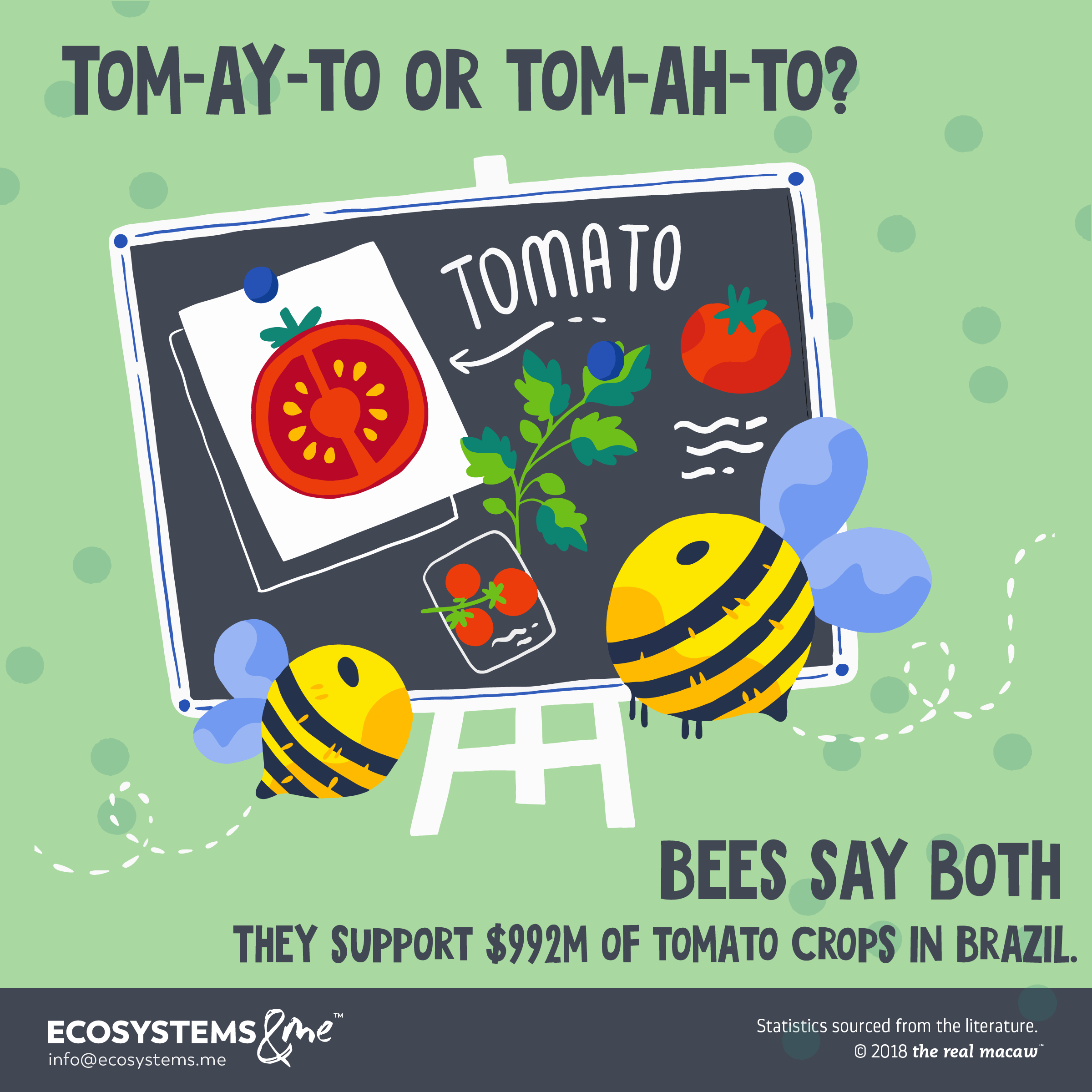
Brazil. Land of beaches, rainforests, cachaca, samba, joga bonito, and… tomatoes? Yes, tomatoes. Believe it or not (and you bet we do!) Brazil produces a lot of tomatoes, most of them in Goiás state. And a lot of those tomatoes depend on bees – for pollination, fruit development (remember, tomato is a fruit!) and crop quality. Not to mention jobs, employment, and income. All from one tiny bee! OK, a lot of tiny bees.
Tomatoes, Brazil, and Goiás
Raise your hand if you’ve heard of Goiás. Yeah, we didn’t think so. It’s not on the coast, it doesn’t have many forests or beaches like other areas of Brazil, and outside of Goiânia, the state capital, it doesn’t have a lot of people. So it’s not surprising that it’s not nearly as well known as Rio, Sao Paulo, or some of Brazil’s other, more famous places. That being said, it is one of the country’s fastest growing areas.
Bees are responsible for ~$1,000,000,000 in Brazilian tomato crops each year.
So what is Goiás famous for? Well, it’s covered with cerrado, which is basically a tropical woodland savanna. Cerrado is ancient – maybe so ancient that it dates back to before South America and Africa separated! And, with favourable growing conditions (fertile land, the right climate, and farming improvements), Goiás has become a tomato growing hub.
So let’s start with a few stats, thanks to our friends at Tomato News (see link above. Aside: Who would’ve thought there was a site just for tomatoes? We sure didn’t.).
- Goiás produced a total of ~1.1 million tonnes of processing tomatoes in 2016 (more in 2017).
- There are 12,300 or so hectares planted.
- Each hectare creates about 7 jobs.
- That makes 86,000 jobs in Goiás alone!
- Every year, the processing tomato industry* is worth around US ~$965 million. That’s for the whole of Brazil, not just Goiás, although it’s the main growing region.
*That’s the ‘processing tomato’ industry, meaning tomatoes that are grown for processing, like into sauces, pastes, etc. – not the industry of processing the tomatoes. Because that industry wouldn’t necessarily include growing the tomatoes themselves. ? (OK, now we’re just trolling.) Also, it doesn’t include table tomatoes (i.e. tomatoes for eating), but these are a tiny part of the total tomatoes.
Bees for bumper crops
A huge number of important crops depend on pollinators like bees or animals. How much so varies with the crop, of course. But without pollination, a plant’s flowers don’t turn into fruit. And without fruit, there is no crop – and no food.
Tomato plants can technically pollinate themselves, and wind sometimes lends a helping hand. But often, they rely on bees – especially since their flowers respond best to ‘buzz pollination‘, in which vibration (like from a bee’s whirring wings) helps loosen and move pollen around.
Bee pollination improves tomato weight by 40%!
For tomatoes in Brazil, 40-90% of yield depends on pollinators, specifically bees. Taking an average of 65% and an estimated total yearly production value of US ~$1.5 billion, bees are responsible for almost $1 billion of the annual tomato crop. Most of that would be in Goiás. And even if the plant pollinates itself, bee visits improve tomato quality: tomatoes weigh ~40% more, and they create ~10% more seeds.
But bee careful
Bees don’t live in tomato plants; they live in habitats. Just like animals (or humans!), they need different types of plants for food and for shelter. This could mean cerrado, or other types of vegetation like caatinga, found in hot, dry areas. In Brazil, climate change or land conversion threatens many of the bees’ preferred habitats. Only 21% of the original, ancient cerrado, for example, is still intact; the rest has already been converted to human uses like farming or raising cattle. And that means that bee populations, which help create jobs by pollinating tomato plants, are also threatened.
Ecosystems and habitats support bees, bees support more than half of the tomato crop, and the tomato crop supports people.
So what does this mean all together? Ecosystems and habitats support bees, bees support most of the tomato crop, and the tomato crop supports jobs and people. Whether that’s by eating a big, juicy tomato or processing it, the result – as always – is that ecosystems support people.
Did you make it through all ~700 words? What did you like the most? Let us know below! ?
